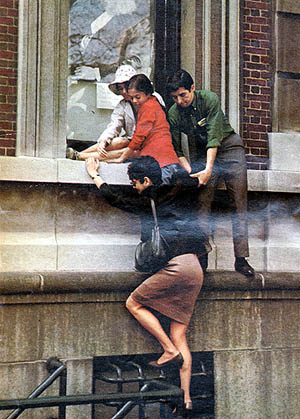This is a repost from Inauguration Day 2017 because a quick search of the news doesn't return any rabble-rousing by Ms. Piven over the last year or so.
Of course, she is 92 years old and may have other concerns. We have also posted the article she did with her husband that made her bones in the poli. sci. and sociology arenas, link in the intro below.
Original post:
You may remember her name if you studied political science or the history of the U.S. in the 1960's.
She and fellow Columbia U. professor Richard Cloward proposed a plan to
achieve their political goals, including universal basic income, that
became known as the Cloward-Piven Strategy.
The strategy was laid out in the May 2, 1966 issue of The Nation magazine in an article titled "The Weight of the Poor: A Strategy to End Poverty" about which the copy hosted at Common Dreams says "The theory here, to force change through chaos, was among the most provocative of the 1960s."
A few years ago The Nation commissioned a new introduction from Ms.
Piven, her husband Mr. Cloward having died in 2001, which the magazine published as part of their 150th anniversary issue.
Here's her latest, again at The Nation, January 18, 2017:
Throw Sand in the Gears of Everything
When it comes to stopping Trump, petitions aren’t going to do it.

As many are saying, we woke from a nightmare to find it was our new reality. A gaggle of inflated far-right self-promoters and operatives, big businessmen and their toadies, and homegrown fascists will control the presidency and determine the Supreme Court majority, maybe for a generation or more. The Congress is firmly in Republican hands, save for the uncertain possibility that Senate Democrats will muster the gumption to filibuster. And that possibility could also evaporate with the 2018 midterm elections, when as many as 20 or more Democrats will have to defend their seats. No wonder that everyone I speak with searches for someone to blame—Clinton or Comey or white women or the white working class or the Bernie troops—and then asks plaintively: What do we do now?
There are lots of answers floating about. State governments should band together to pass laws that bind their representatives in the Electoral College to support the winner of the popular vote. Or we should begin the hard work of reconstructing the Democratic Party, finally purging the influence of the Democratic Leadership Council and its Wall Street allies, so that it speaks more convincingly to the aspirations of working people and minorities. Or we should push for the reforms that will somehow prevent gerrymandered districts after the 2020 Census. Or we should restore the Voting Rights Act and push for automatic voter registration. And of course—again, somehow—we should restrict the role of big money in elections.
I support all of these efforts, needless to say, and I sign the petitions and respond to the fund-raising appeals that their advocates generate. But I am not very hopeful that any of them can succeed, at least not in the limited time we have to protect the planet from global warming or nuclear catastrophe or both.
There is another impulse evident in the spontaneous reactions that followed Trump’s election in the streets of New York City, Los Angeles, San Francisco, Oakland, Baltimore, Kansas City, Milwaukee, Miami, Portland, and elsewhere. Lots of people—especially young people—gathered, made speeches, marched, shouted, and held up signs and banners. All of us who participated can report the lift to our morale the experience offered. We were performing the elementary rites of a social movement, rites that the influential historian Charles Tilly labeled “WUNC”—meaning that people gather together to demonstrate their worthiness, unity, numbers, and commitment.
Chanting crowds are the familiar insignia of movements. And I think movement politics may even make resistance to a Trump regime possible. But while the great movements of American history were the crucial determinant of our most important democratic reforms—from the basic electoral elements of representative democracy, to Emancipation, to labor rights, to women’s and LGBTQ rights—none of these movements achieved their successes simply through the gathering of people to show their commitment. People gathered, of course, but what makes movements a force—when they are a force—is the deployment of a distinctive power that arises from the ability of angry and indignant people to at times defy the rules that usually ensure their cooperation and quiescence.
Movements can mobilize people to refuse, to disobey, in effect to strike. In other words, people in motion, in movements, can throw sand in the gears of the institutions that depend on their cooperation. It therefore follows that movements need numbers, but they also need a strategy that maps the impact of their defiance and the ensuing disruptions on the authority of decision-makers.
The repercussions of such mass refusals can be far-reaching, simply because social life depends on systems of intricate cooperation. So does our system of governance. Perhaps the US government, with its famous separation of powers on the national level and its decentralized federal structure, is especially vulnerable to collective defiance. To be sure, the right wing has now taken over many of the veto points in the national government, and it dominates half of the state governments as well (although that could change in 2018, when many hard-right Republican governors will be defending their seats). But the big cities, where a majority of the population lives, have not been captured. Center-left mayors preside over cities like New York, Los Angeles, Boston, Seattle, and San Francisco, for example. And that fact can nourish urban resistance movements.
People don’t easily break the rules of institutional life, and especially not collectively and publicly, if only because of the punishments that can be visited on rule-breakers. Think of the possible responses of a Trump administration! And, in fact, movements from the lower reaches of society—whose members are often the most marginalized and vulnerable—usually don’t emerge if people think they’ll have no influence over the regime in power. People are much likelier to risk defiant collective action if leading politicians appear accountable to movement constituencies. The great strike movement among industrial workers arose under Franklin Roosevelt, who promised to speak for “the forgotten man” in the midst of the Great Depression. The civil-rights movement escalated at least partly because of the reluctant encouragement of Democratic presidents newly concerned about the loyalty of urban black voters, and it triumphed under a president who felt it strategic to echo the words of the civil-rights anthem “We Shall Overcome.”
* * *There’s a slogan among organizers to the effect that all organizing is local, meaning that people come together in local workplaces and communities to articulate their grievances and their hopes, and to develop the muscle to act. Local organizing against Trump’s initiatives will be bolstered by the support of local politicians, and movement organizing in turn can stiffen the backs of local politicians when the Trump administration threatens to cut funding to city governments. There would be many opportunities to play a role: Even ordinary householders can take in and shield immigrants. And all of us can render registries useless by insisting on registering ourselves as Muslims or Mexicans or Moldovians. A sanctuary movement gives lots of people a role that matters. Most important, in our complex federal system, where the policies of the national government depend on cooperation by state and local authorities, these local movements have the potential to block initiatives by the incoming Trump regime. ...MUCH MORE
Professor Piven's most impactful effort is the little acknowledged 1993 "Motor Voter" Act.
I've mentioned it a few times, here's one from last winter:
If I were a Democrat strategist I would propose letting Donald Trump win a second term while concentrating on House and especially Senate (to bottle up judicial, including Supreme Court, nominees) races.
A Trump win would give an excuse for riots (for the visuals) and if he is handcuffed by the Legislative branch to limit the range of possible responses, you go beyond polycrisis to the omnicrisis. Throw in a bit of Frances Fox Piven with her "overwhelm the system" and "motor voter" strategies and you could see one-party rule for thirty years.
Here's Professor Piven back in the day:
Columbia University 1968 - Photo #38 - Elsewhere on campus

Photo: Life Magazine, 10 May 1968.
Acknowledgment: Professor Holly Ackerman, University of Miami, Florida, formerly of the Columbia School of Social Work, for identifying Professor Piven, and Prof. Piven herself for confirmation.